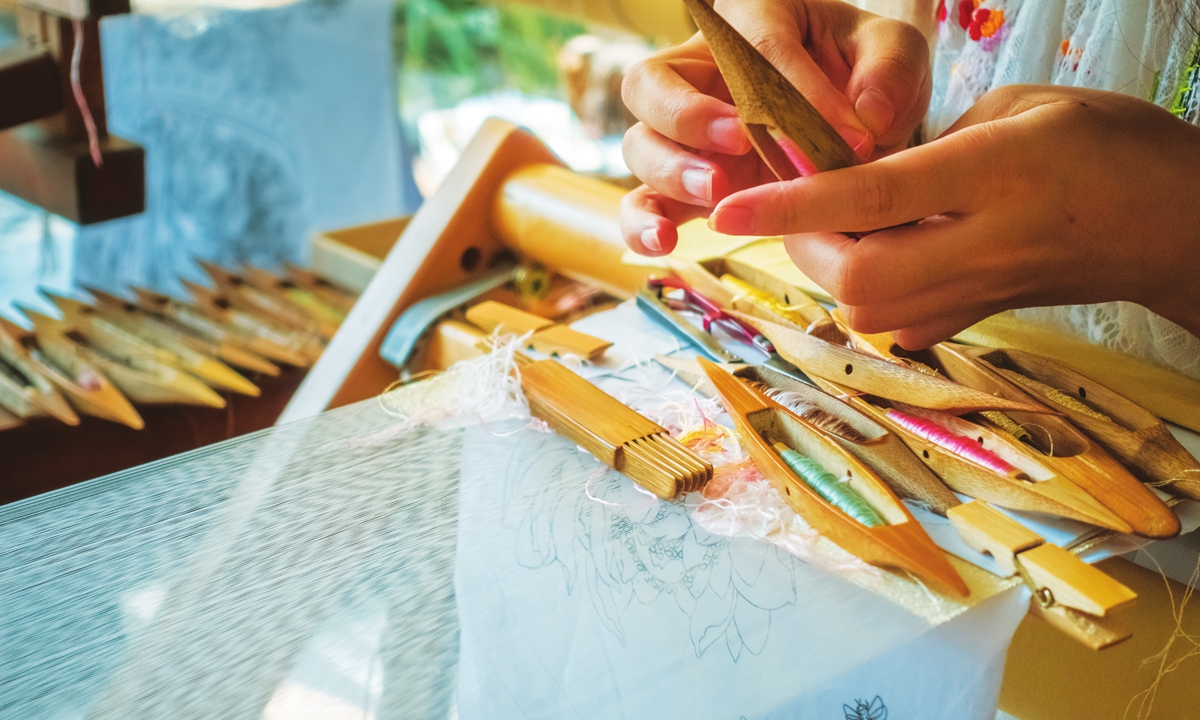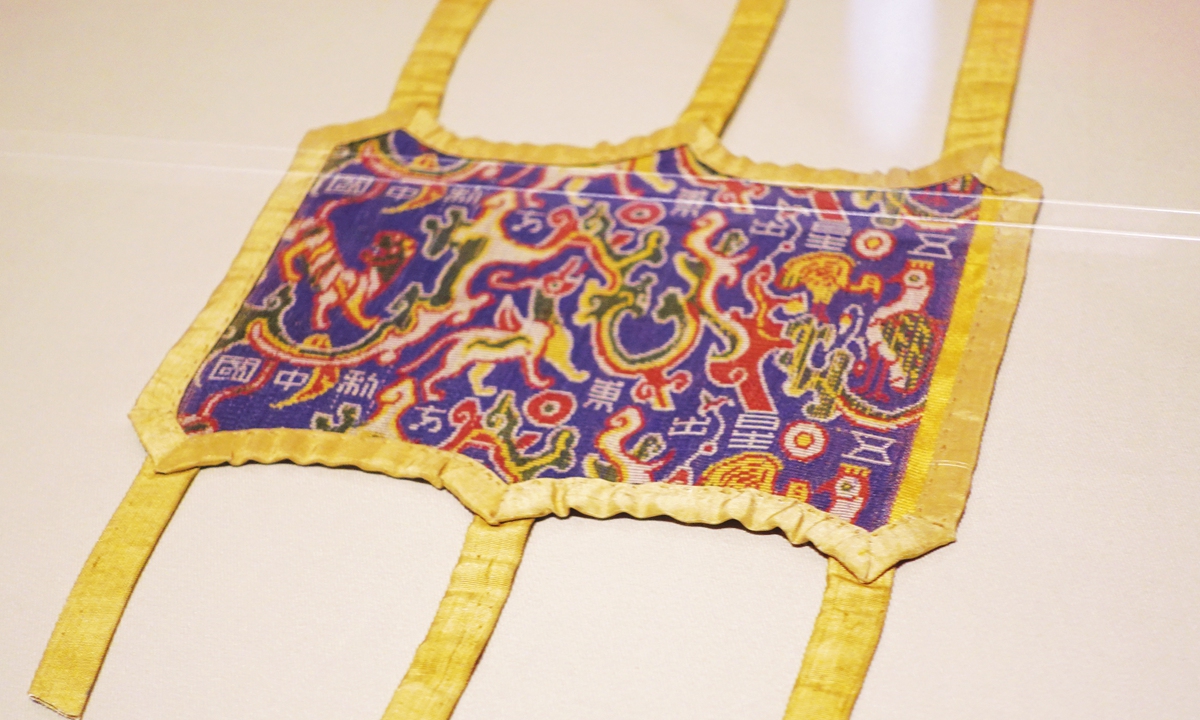
A weaver spins threads. Photo: VCG
"You still can see the original vivid colors from 2,000 years ago," Qian Xiaoping, an 83-year-old Chinese silk expert, said when describing the Han Dynasty (206BC-AD220) brocade known as "Wuxing Chu Dongfang Li Zhongguo" (Five Stars Rise in the East Favoring China). Discovered along the ancient Silk Road in the Xinjiang Uygur Autonomous Region, the relic is the earliest brocade to feature the characters Zhongguo (Lit: Middle Kingdom), or "China."
Qian told the Global Times that the treasure instilled in her pride because she was the first artisan to make the first-and-only 1:1 replica of the brocade.
Her replica brocade was viewed by Chinese President Xi Jinping when he visited the Xinjiang Museum in mid-July.

Five Stars Rise in the East Favoring China, the Han Dynasty (206BC-AD220) brocade unearthed in Xinjiang Photo: IC
Chinese wisdomQian revealed to the Global Times that after she was invited by the State Administration of Cultural Heritage in 1999 to replicate the Han Dynasty brocade she had spent numerous sleepless nights working to complete the project as it had to remain as close to the original as possible when it came to the materials and techniques used.
The brocade was an arm guard. Only around the size of a grown man's palm, it was embroidered with the phrase "Five stars rise in the east favoring China" to refer to the ancient belief that when Mercury, Venus, Mars, Jupiter and Saturn appear in the sky at the same time, it will bring China victory.
"The brocade is seen by many experts as a wish by the governor of the region for victory in war.
Though many myths remain a puzzle, we can see that Chinese culture was respected by China's western regions thousands of years ago," Zhang Dao, a historian, told the Global Times.
Qian recalled that she was only able to examine the original work through a glass window and so had to rely on a fabric density magnifier and her 60 years of silk experience to grasp the structure of the weave.
"Wu chong jing jin," also known as the "five layered silk jacquard technique," was the key to getting the replication right. The technique uses five colored silk threads for the horizontal warp threads and plainer silk for the vertical weft threads, causing the resulting pattern to have a strong stereoscopic feel. "It left me speechless. I never imagined such advanced silk making techniques existed thousands of years ago," Qian said.
Weaving 220 silken warp threads for every 1 centimeter of cloth, this fine craftsmanship was not the only challenge Qian faced-the process of dyeing the threads also gave the modern maker even more sleepless nights. "Modern dyeing faded away after a month, I couldn't sleep since I was constantly thinking about the problem," Qian remarked.
In 2003, the ancient brocade replica was completed after Qian resolved the dyeing issue by abandoning modern methods and turning to the natural dyeing methods used by the ancients aided by a "color enhancer" of her own design. Qian said such replicas act as archives of Chinese wisdom. The success of the replica inspired her to continue down this road of preserving history.
In 2016, Qian and her team duplicated a Qing Dynasty (1644-1911) painting scroll Sukhavati. Embodying the Chinese connection to Buddhist culture, the painting was gifted by the Qianlong Emperor to his mother. Qian transferred the 278 Buddhist figures depicted on paper to a silk version that now hangs in the Palace Museum in Beijing.
'Silk architect'
As China's only national-level Song Dynasty (960-1279) brocade inheritor, Qian has been seeking creative breakthroughs such as China-West silk culture exchanges to promote the silk art that originated in her hometown of Suzhou, Jiangsu Province, and was later listed as a national protected intangible cultural heritage in 2006.
In 2021, the 82-year-old lady cooperated with the Italy-based Amedeo Modigliani Scientific Research Foundation to bring 10 Chinese silks featuring portraits from the 20th century European master to an exhibition. "The granddaughter of Modigliani sent photos to us showing the print paintings of her grandfather's works. When we sent our works to Italy, they were astonished by how seamless the Chinese silk merged with European art.
"Chinese silk brings the smooth, mellow and glossy aesthetics of these on-canvas works back to life," Qian remarked.
Qian's journey to bring Chinese silk culture to the West has never stopped. In the early 2000s, she traveled to France, Japan and Sweden for exhibitions and seminars on Chinese Song brocade. "Japan and France have their own silk culture, but when people see Chinese silk, they see the differences. Such differences make them want to learn more about Chinese culture," Qian said.
Qian also founded the Suzhou Silk Museum, which keeps her busy as a creative designer despite having retired years ago.
She wakes up at 5 am everyday to schedule studio meetings and constantly travels to different places for research. According to her colleagues, her minds functions as well as a "high-tech computer chip."
"But you know, I'm not just an artisan, I'm a 'silk architect.' I make works that require rigorous thinking about materials, structures and more. Such qualities are why our Chinese silk art is unique," Qian noted.





